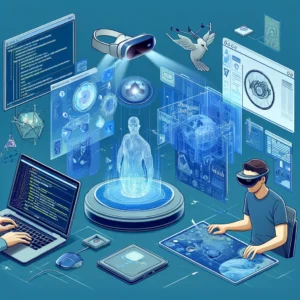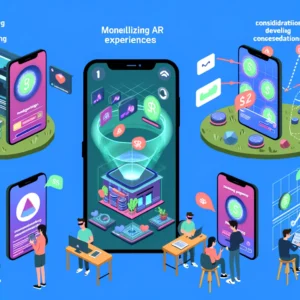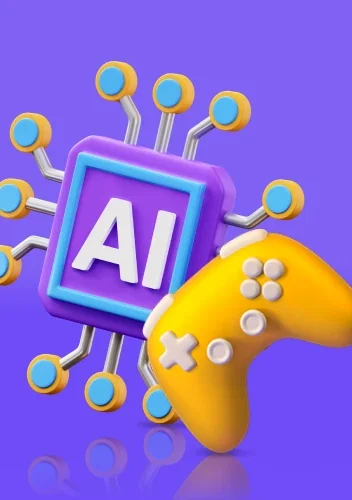AR Developer Kit: Next-Level Gaming Experiences
KEY POINTS OF THE ARTICLE
- Apple Vision Pro combines AR and computer vision for enhanced AR experiences
- AR app development boosts functionality of Apple Vision Pro in education, business, entertainment, retail, and manufacturing industries
- Augmented reality app development offers increased engagement, improved learning, enhanced collaboration, and innovative experiences
- AR developers face challenges such as hardware limitations, software development challenges, user acceptance, and feature enhancement
- Leveraging AI technologies and implementing strategies for user acceptance and engagement can overcome these challenges
Introduction
Augmented Reality (AR) has revolutionized the way we interact with digital elements, offering immersive experiences that blend virtual and real-world environments seamlessly. From enhancing gaming experiences to transforming medical training, AR technology has unlocked endless possibilities across various industries. As technology advances, the integration of AR into everyday life presents a significant leap forward in how we perceive and engage with the world around us. Developers now have the tools to create interactive and engaging content that bridges the gap between the physical and digital realms. This blog delves into the evolution of AR, the impact of developer kits, and the exciting prospects that AR brings to the forefront of innovation.
The Evolution of Augmented Reality: From Concept to Developer Kits
Augmented reality (AR) and virtual reality (VR) have come a long way since their inception. The concept of overlaying digital content onto the real world has fascinated researchers and developers for decades. As technology advances, AR has evolved from simple prototypes to sophisticated developer kits that empower creators to bring their AR visions to life. The evolution of AR has been driven by advancements in computer vision, machine learning, and graphics processing, which have made it possible to create immersive and interactive AR experiences. Today, AR developer kits provide the tools and resources needed to harness the power of AR and create captivating experiences for users.
Tracing the Origins and Milestones of AR Technology
ChatGPT responds to human prompts, with output quality depending on the prompt. Good prompts ensure accuracy and optimize performance.
Creating website copy that converts visitors is challenging. With effective strategies, your copy can resonate with your audience, convey product value, and boost sales.
Movies inspire, comfort, and entertain us. Our list covers a century of cinema globally, from blockbusters to cult classics.
AR technology began in the 1960s by overlaying virtual elements on the physical world. Advances in machine learning and object recognition have driven AR into industries like gaming and medical training for immersive experiences blending digital and physical worlds.
The Role of Developer Kits in Advancing AR Experiences
Developer kits are crucial for advancing AR experiences. They provide essential tools for software development, empowering developers to seamlessly integrate AR technology into their projects. This integration unlocks endless possibilities for innovative applications, creating immersive experiences that blend virtual elements with the physical world. By combining AR development tools, machine learning, and object recognition, developers can offer users a whole new level of experience and spatial awareness. Developer kits bridge the gap between digital content and reality, driving the evolution and growth of AR technology.
Understanding AR Developer Kits: Tools That Shape Reality
AR developer kits are powerful tools that shape the reality of augmented reality experiences. These kits provide developers with the necessary software, tools, and resources to create immersive and interactive AR content. AR developer kits include software development kits (SDKs) that offer libraries, APIs, and documentation for building AR applications. These kits enable developers to overlay digital content onto the real world, creating a seamless integration of the virtual and physical environments. With AR developer kits, developers can create realistic 3D models, animations, and ar interactive elements that enhance user engagement and provide unique and innovative experiences. These tools empower developers to shape the reality of AR and unlock the full potential of this transformative technology.
Key Components and Features of Leading AR Developer Kits
AR developer kits comprise essential components like software development tools, object recognition capabilities, and spatial awareness features. These kits enable the integration of AR into various devices, offering developers a comprehensive set of resources to create immersive AR experiences. One of the key features is the seamless combination of digital and physical elements, enhancing user engagement and interaction. Moreover, these kits often include machine learning algorithms for advanced functionalities, empowering developers to design innovative AR applications. The ability to overlay virtual elements onto the physical world in real-time is a significant leap in AR technology, opening up endless possibilities for gaming and beyond.
Comparing Popular AR Development Platforms: Strengths and Limitations
When exploring AR development platforms, consider their strengths and limitations. Each platform offers unique features catering to various aspects of AR development. Unity excels in AR development tools and game mechanics, while arkit interact with objects seamlessly integrates AR features into iOS devices. Understanding these factors is crucial for successful AR experiences.
Step-by-Step Guide to Creating Your First AR Project
Creating your first AR project can be an exciting and rewarding experience. Here is a step-by-step guide to help you get started:
- Define your AR project: Determine the goals and objectives of your AR project. Identify the target audience and the type of immersive experience you want to create.
- Choose an AR development platform: Select the AR development platform that best suits your needs and offers the desired features and capabilities.
- Plan your AR experience: Design the user interface, interactions, and content for your AR experience. Consider the user journey, storytelling elements, and game mechanics if applicable.
- Develop your AR application: Use the tools and resources provided by the AR development platform to create your AR application. Implement the user interface, integrate digital content, and test the functionality.
- Test and iterate: Test your AR application on different devices and in different physical environments. Gather feedback from users and make iterative improvements based on their input.
- Deploy and market your AR application: Publish your AR application on the relevant app stores and create a marketing strategy to promote your application to the target audience.
By following these steps, you can create your first AR project and deliver an immersive experience that captivates users and showcases the potential of AR technology.
Setting Up Your Development Environment
To embark on creating immersive AR experiences, setting up your development environment is crucial. Incorporating artificial intelligence and machine learning, AR development involves integrating digital elements into the physical world. As you delve into this next-level gaming experience, spatial awareness and object recognition become key. Understanding the capabilities of AR devices is essential, considering the level of immersion and reality technology required. Development tools play a significant role in the process, enabling game developers to bring virtual elements into the real world seamlessly. By setting up your development environment effectively, you pave the way for exploring the endless possibilities that AR technology offers, taking your gaming experience to a whole new level.
Designing Interactive and Engaging AR Content
Augmented Reality (AR) offers a whole new level of immersive experiences by integrating digital elements into our physical surroundings. Designing interactive and engaging AR content involves considering the spatial awareness and capabilities of AR to create a seamless blend of virtual and real-world elements. Developers leverage object recognition, machine learning, and artificial intelligence to enhance user engagement within the AR experience. By incorporating game mechanics and interactive features, AR content can provide a significant leap in user experience. Designers need to balance the level of immersion with the need for user-friendly interfaces to ensure a seamless interaction between the digital and physical worlds. Embracing the endless possibilities of AR technology, the design process aims to create captivating experiences that captivate users and push the boundaries of reality games.
Innovations in AR: How Developer Kits are Expanding Possibilities
AR developer kits are revolutionizing AR technology, pushing boundaries and making science fiction a reality. These kits empower developers to explore cutting-edge technologies like machine learning and spatial mapping for immersive AR experiences that enhance user engagement across industries. The evolving nature of AR developer kits promises endless possibilities for transformative AR experiences.
Breakthroughs Enabled by Advanced AR Technologies
Breakthroughs Enabled by Advanced AR Technologies:
Advanced AR technologies have revolutionized immersive experiences by integrating artificial intelligence and machine learning in developer kits. These advancements enable object recognition, spatial awareness, and seamless blending of digital and physical environments. This innovation enhances user engagement by creating virtual elements that interact with real-world objects, expanding possibilities beyond traditional gaming into fields like medical training and digital content creation.
Real-World Applications Transforming Industries
Real-world applications are revolutionizing industries through augmented reality (AR) technology. AR is transforming medical training, gaming, architecture, design, retail, and manufacturing. It enhances user engagement by blending digital elements with the physical world, offering innovative interactive experiences.
Enhancing User Experience with AR: Best Practices for Developers
To enhance user experience with AR, developers must focus on creating immersive AR experiences. By leveraging the capabilities of AR and integrating spatial awareness, developers can offer users a whole new level of immersion. Incorporating object recognition and machine learning technologies can further enrich AR experiences by bringing digital elements seamlessly into the physical world. Ensuring a high level of user engagement is crucial in the gaming industry, where AR development plays a significant role. By understanding the needs of users and optimizing AR features for different devices, developers can take AR gaming to the next level, offering users a truly interactive and engaging experience.
Tips for Designing Intuitive AR Interfaces
When designing intuitive AR interfaces, consider the user’s spatial awareness and the integration of AR elements into their physical surroundings. Utilize machine learning for object recognition and spatial mapping to enhance the user experience. Incorporate social interaction features to promote user engagement. Ensure the interface is user-friendly across different devices for a seamless experience. Focus on the level of immersion to create captivating AR experiences. Prioritize user feedback to continuously improve the interface design. Keep abreast of technology advances in AR development to stay competitive in the gaming industry. Balancing aesthetics with functionality is crucial for successful AR interface design.
Ensuring Seamless Integration with Existing Technologies
Augmented reality (AR) developer kits must ensure seamless integration with existing technologies to provide users with immersive experiences. By leveraging advancements in artificial intelligence and machine learning, AR solutions can blend digital elements with physical surroundings, offering endless possibilities for interactive engagement. Ensuring compatibility with popular social media platforms allows for enhanced social interaction within AR environments. Integration of AR technology with object recognition facilitates a higher level of immersion, engaging users in a virtual environment that mirrors the real world. Developers face the significant challenge of balancing the capabilities of AR with development costs to create compelling AR experiences that seamlessly integrate with various types of devices and software platforms.
Overcoming Challenges in AR Development
Augmented Reality (AR) development presents a significant challenge due to its intricate nature and the need for advanced technology. Developers must navigate through various hurdles, such as the integration of AR with different devices and the high development costs involved. Ensuring a seamless blend of virtual elements with the physical world requires precise spatial awareness and object recognition capabilities. Moreover, maintaining user engagement and a high level of immersion in AR experiences adds another layer of complexity. Despite these challenges, the continuous advancement of technology, including machine learning and artificial intelligence, provides new opportunities for overcoming obstacles in AR development and taking interactive experiences to the next level. Integrating AR features seamlessly into software development processes is crucial for achieving success in this ever-evolving field.
Addressing Common Pitfalls and How to Avoid Them
Creating immersive AR experiences comes with its challenges. One significant pitfall is the development costs associated with AR projects. To avoid this, meticulous planning and efficient utilization of AR development tools are crucial. Moreover, ensuring the integration of AR features tailored to different devices can enhance user engagement while managing expenses. Another common issue is the level of immersion generated by AR applications. To overcome this, game developers can leverage machine learning and AI to enhance spatial awareness and object recognition, thus elevating the overall AR experience. By addressing these pitfalls proactively, developers can harness the full potential of AR technology and offer users truly unforgettable interactive experiences.
Optimizing Performance for Diverse Devices
To ensure optimal performance across a range of devices, developers must consider the diverse capabilities and specifications of each platform. Different devices vary in processing power, display resolutions, and sensors, requiring tailored optimization strategies for seamless AR experiences. By leveraging machine learning and object recognition, developers can adapt content dynamically to suit the characteristics of the device used. Spatial awareness and integration of AR with the physical environment are crucial for enhancing user engagement and immersion. Efficient utilization of development tools and resources is key to delivering consistent performance on smartphones, tablets, and AR glasses, catering to a broad audience and expanding the reach of interactive ar applications.
The Future of AR Development: Trends and Predictions
The future of AR development looks promising with advancing technology trends. AI and machine learning integration will enhance AR experiences, making them more immersive. Social media platforms will use AR for increased user engagement, bridging physical and digital worlds. Lower development costs will benefit game developers and other industries. Spatial awareness and object recognition will improve user experiences, revolutionizing interactions between digital and physical environments.
Emerging Technologies Shaping the Future of AR
Emerging technologies are shaping the future of AR development. Here are some key technologies to watch out for:
- Virtual Reality (VR): VR technologies are becoming increasingly integrated with AR, enabling more immersive and interactive experiences. The combination of AR and VR technologies will blur the lines between the real and virtual worlds, offering users a whole new level of immersion.
- Eye-tracking technology: Eye-tracking technology allows AR applications to detect and respond to users’ eye movements, enhancing the level of interaction and providing more intuitive controls and experiences.
- Haptic feedback: Haptic feedback technology provides users with tactile sensations, allowing them to feel virtual objects in the real world. This technology will enhance the level of immersion and realism in AR experiences.
These emerging technologies hold great potential for the future of AR development, opening up new opportunities for creating immersive and interactive AR experiences.
Anticipating the Next Big Thing in AR Experiences
As technology advances, augmented reality (AR) offers endless immersive possibilities. Developers push AR boundaries for enhanced digital-physical interactions. Integrated into gaming and social media, AR could revolutionize experiences from social interaction to medical training, blending digital elements with our physical world seamlessly.
Case Studies: Successful AR Projects and Their Impact
Case studies of successful AR projects demonstrate the impact that AR technology can have across various industries. Here are some examples:
- Medical Training: AR has transformed medical training by providing realistic surgical simulations and patient interactions. Surgeons can practice complex procedures in a risk-free virtual environment, leading to improved surgical skills and patient outcomes.
- Retail: AR has revolutionized the retail industry by offering virtual try-on experiences and interactive product demonstrations. Customers can visualize products in their homes before making a purchase, leading to increased sales and reduced returns.
- Education: AR has enhanced education by providing interactive and immersive learning experiences. Students can explore historical sites, visualize complex concepts, and engage in virtual laboratory experiments, leading to improved knowledge retention and engagement.
These case studies highlight the transformative power of AR and its potential to revolutionize industries and enhance user experiences.
Innovative AR Applications Across Different Sectors
Augmented reality (AR) has transcended the gaming realm, finding innovative applications across various sectors. Medical training benefits from AR’s ability to overlay digital content onto physical objects, enhancing learning experiences. In the retail industry, AR allows customers to visualize products in real-time within their physical surroundings before making a purchase, revolutionizing the shopping experience. AR technology advances have paved the way for immersive experiences in tourism, where users can explore destinations virtually before booking their trips. Moreover, AR is making significant strides in education by creating interactive lessons that engage students through virtual elements. The potential of AR across different sectors holds promise for transforming how we interact with technology and the world around us.
Lessons Learned from Leading AR Development Projects
Leading AR development projects have unveiled valuable insights, showcasing the significance of seamless integration of AR elements to deliver immersive user experiences. These projects emphasize the importance of leveraging machine learning and object recognition for enhanced spatial awareness within virtual environments. By balancing user engagement with the capabilities of AR, developers have pushed the boundaries to create innovative gaming experiences and practical applications in various industries. Challenges encountered in development costs and technological constraints have highlighted the need for continuous innovation and collaboration within the AR developer community. These lessons underscore the immense potential of AR technology and the necessity for strategic planning to maximize the impact of AR experiences.
Bridging the Gap: AR Developer Community and Collaboration Opportunities
For AR developers, building a strong community and fostering collaboration are essential. Engaging in forums, workshops, and events tailored to AR provides valuable networking opportunities and access to shared knowledge. These interactions enable developers to stay updated on the latest trends, tools, and best practices, propelling their projects to new heights. Leveraging the collective expertise within the AR community can lead to innovative solutions and breakthroughs in immersive AR experiences. By connecting with like-minded individuals, developers can address challenges more effectively, share insights, and spark creativity in their projects. Collaboration not only enriches the development process but also cultivates a supportive ecosystem for creating cutting-edge AR applications.
Forums, Workshops, and Events for AR Developers
Forums, workshops, and events play a crucial role in fostering collaboration and innovation within the AR developer community. These platforms provide invaluable opportunities for developers to exchange ideas, share insights, and stay updated on the latest trends and technologies. Popular forums like Stack Overflow and Unity Community are hotspots for discussing AR development challenges and solutions. Workshops offer a hands-on approach to mastering AR tools and techniques, while events like the AWE Expo bring together industry experts to showcase cutting-edge AR projects. Engaging with these resources not only enhances technical skills but also cultivates a supportive network that empowers developers to push the boundaries of AR technology.
Leveraging Community Knowledge for Project Success
By tapping into the collective expertise within the AR developer community, project success can be significantly enhanced. Collaboration and knowledge-sharing platforms offer invaluable insights into overcoming challenges and unleashing innovative solutions. Engaging with forums, attending workshops, and participating in AR events connect developers with peers, fostering a rich ecosystem of support and learning. Leveraging this communal knowledge not only accelerates project development but also ensures a comprehensive understanding of the latest trends and best practices in AR technology. Embracing community-driven collaboration opens up a world of possibilities for refining AR experiences and staying at the forefront of technological advancements.
Monetizing AR Experiences: Strategies and Considerations
Augmented Reality (AR) offers a realm of endless possibilities for immersive experiences, making monetization strategies a significant challenge. To capitalize on this emerging field, developers must consider balancing user engagement while generating revenue. Various revenue models exist, from in-app purchases to advertising, each impacting the user experience differently. By understanding the social interaction and level of immersion AR provides, developers can tailor monetization approaches effectively. Furthermore, considerations like development costs and user acceptance play crucial roles in shaping successful AR applications. As technology advances, exploring innovative ways to monetize AR experiences will be pivotal in driving the growth of this exciting industry.
Exploring Revenue Models for AR Applications
When considering revenue models for AR applications, various strategies can be employed, such as in-app purchases, subscription models, and advertisements. In-app purchases allow users to buy virtual goods or enhanced features within the application, leading to a direct revenue stream. Subscription models provide continuous access to premium content or features for a recurring fee. Integrating advertisements can generate revenue through sponsorships or partnerships. AR applications can also explore collaborations with brands for product placements within the virtual environment. Another avenue is offering freemium versions with basic features and options for users to upgrade for a fee. Balancing user engagement with monetization is essential for long-term success in this evolving landscape.
Balancing User Engagement and Monetization
Creating a successful AR experience involves striking a delicate balance between user engagement and monetization. While captivating users with immersive AR features is crucial for retention, monetization strategies need to be seamlessly integrated without compromising user experience. Incorporating ads, in-app purchases, or subscription models should enhance the overall experience rather than disrupt it. Leveraging user data ethically and offering value-added services can also drive revenue while keeping users engaged. Understanding user behavior through data analytics and feedback loops is essential in optimizing both engagement and monetization strategies. By prioritizing user satisfaction and continuously refining monetization tactics, developers can achieve sustainable success in the competitive AR market.
Conclusion
In the dynamic realm of augmented reality, developer kits are the gateway to innovative experiences. These tools not only facilitate the creation of engaging AR content but also drive the evolution of technology. By understanding the components and features of leading AR developer kits, developers can unlock a world of possibilities. Embracing best practices, navigating challenges, and staying attuned to emerging trends are crucial for shaping the future of AR development. As AR continues to revolutionize industries and user experiences, fostering collaboration within the AR developer community becomes paramount. To explore the vast horizons of AR development and embark on your AR journey, reach out and get in touch for a transformative experience.





















